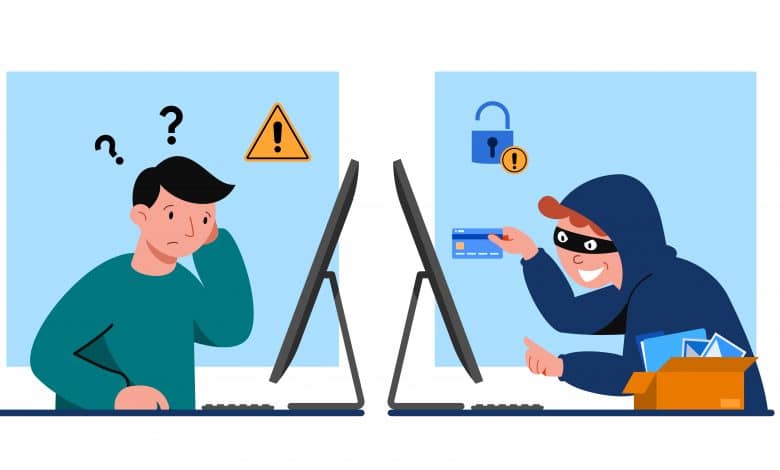Amazon Scams—The Down, the Dirty, and the Devious

Casting a wide shadow in the landscape of online shopping, Amazon is a pioneer unlike any other, offering customers an unparalleled selection of products and convenience. However, as with any popular platform, Amazon has attracted a fair share of scammers ready to pounce on innocent shoppers.
Let’s explore some of the worst Amazon scams, shedding light on their deceptive workings and providing invaluable tips to help you navigate its virtual aisles safely. By staying informed and vigilant, you can protect yourself from being another victim of a scam.
#1Email Phishing
How it works:
Email phishing works in two parts. First, the would-be scammer sends an email disguised as an official Amazon communication. These emails either claim that there is an issue with a customer’s orders, account. They could also contain malicious links.

Second, the email tries to convince the Amazon customer into revealing sensitive information or into clicking the link. These emails are deceptively authentic, using Amazon branding and logos. However, it is crucial to remember that legitimate emails from Amazon will never ask for personal information or login credentials.
How to avoid it:
- Exercise caution when receiving emails requesting personal information, especially if they seem urgent or threatening.
- Avoid clicking on links or downloading attachments from suspicious emails, as they may contain malware or direct you to fake websites.
- Instead of clicking on any provided links, manually log into your Amazon account by typing the website address directly into your browser.
- If you have concerns about an email, contact Amazon's customer support directly to verify its authenticity.
- Keep your computer and devices protected with up-to-date antivirus software and firewalls to mitigate the risk of phishing attacks.
#2Gift Card Scams
How it works:
Phone calls, emails, and social media messages are the favorite tools for this kind of Amazon scam. Scammers contact their potential victims through these varied means, claiming to represent Amazon or affiliated companies. They convince victims to purchase Amazon gift cards as payment for outstanding debts, taxes, or, most commonly, to claim a prize. Once the gift card codes are provided, scammers quickly redeem them, leaving victims hanging in the air.
In pressuring someone into buying an Amazon gift card, scammers use a variety of tactics. They may impersonate authority figures or create a sense of urgency, making victims believe they must act immediately. Sometimes, the pressure can take the form of implied blackmail. Once the victim provides the relevant code, scammers immediately use them for their own benefit.
How to avoid it:
- Be cautious of unsolicited phone calls, emails, or messages that request payment via Amazon gift cards.
- Remember that legitimate organizations, including Amazon, will not ask for payment in the form of gift cards.
- Verify the legitimacy of any requests by contacting the company directly through official channels.
#3Overpayment Scams
How it works:
In this kind of Amazon scam, scammers contact Amazon sellers, posing as buyers who have overpaid for their product and requesting a refund of the excess. Usually, the request is routed through an alternative payment method like a wire transfer or a third-party payment platform. In reality, the initial payment is fraudulent, and once the seller refunds the excess amount, they will lose money.

Scammers manipulate sellers by presenting a convincing story of overpayment. They may provide false transaction details or manipulate screenshots to make them appear legitimate. By pressuring sellers to refund the excess amount, scammers aim to exploit their trust and financial loss.
How to avoid it:
- Be skeptical of buyers requesting refunds for the overpayment.
- Verify the transaction details independently, such as checking your Amazon account and payment history.
- Process refunds only through the original payment method used for the transaction.
#4Review Manipulation Services
How it works:
Fake ratings and false reviews are the name of the game. Scammers approach Amazon sellers, promising to artificially inflate product ratings and manipulate reviews to boost sales. Glowing reviews and top-notch ratings on one hand, a hefty fee on the other. This unethical practice misleads actual and potential customers, destroying any notion of a genuine feedback ecosystem.

Scammers exploit sellers' desire to improve product ratings and increase sales. They offer services to post fake positive reviews, lower negative reviews, or manipulate ratings through multiple accounts. These tactics can mislead potential customers and negatively impact sellers who choose not to engage in such practices.
How to avoid it:
- Maintain ethical business practices and do not engage with review manipulation services.
- Encourage genuine feedback from customers and focus on improving product quality and customer satisfaction.
- Report suspicious or fake reviews to Amazon's customer support.
#5Fake Reviews and Counterfeit Products
How it works:
Scammers employ manipulative tactics to influence product ratings and reviews, thereby misleading customers and tarnishing Amazon's reputation. They create fake accounts or pay individuals to write positive reviews for their products, tricking unsuspecting shoppers into believing they are purchasing high-quality items. This scam not only leads to financial losses but also undermines trust within Amazon's marketplace.
How to avoid it:
- Scrutinize product reviews, paying close attention to those with suspiciously similar wording or excessive praise. Genuine reviews are often more diverse in their content and tone.
- Look for verified purchase labels on reviews, which indicate that the reviewer has actually purchased and used the product. These reviews are typically more reliable.
- Compare the overall product rating with the individual seller's rating. If the product rating is significantly lower than the seller's rating, exercise caution and investigate further before making a purchase.
- Be wary of products with overwhelmingly positive ratings but a limited number of reviews, as they may be the result of review manipulation.
- Take note of any negative reviews that raise concerns about counterfeit products, poor quality, or delivery issues.
#6Fake Shipping Confirmation Scams
How it works:
Scammers send fraudulent emails or text messages that appear to be legitimate shipping confirmations from Amazon. These messages contain a tracking number and a link to track the supposed package. However, the link leads to a fake website designed to collect personal information or install malware on the victim's device.
Scammers exploit customers' anticipation and curiosity about their orders by sending fake shipping confirmations. The emails or text messages often mimic Amazon's branding and design, making them appear authentic. When victims click on the tracking link and provide their personal information, scammers can use it for identity theft or gain unauthorized access to their devices.
How to avoid it:
- Be cautious of unexpected shipping confirmation emails or text messages, especially if you haven't recently made an order.
- Double-check the sender's email address and verify the legitimacy of the message by logging into your Amazon account separately.
- Avoid clicking on suspicious links and instead track your orders directly through the official Amazon website or app.
#7Account Takeover Scams
How it works:
Scammers employ various tactics, such as phishing emails, malicious software, or stolen login credentials, to gain access to Amazon accounts. Once they have control, they can make unauthorized purchases using the victim's stored payment methods or access sensitive personal information.
Scammers trick users into revealing their login credentials through phishing emails or by directing them to fake login pages that resemble Amazon's website. Alternatively, they may use malware to capture login information from compromised devices. With access to the account, scammers exploit the victim's stored payment methods and personal data for their own gain.
How to avoid it:
- Be cautious of suspicious emails or messages asking you to log in to your Amazon account.
- Always verify the legitimacy of the login page by checking the URL and ensuring it starts with “https://www.amazon.com/“.
- Enable two-factor authentication for your Amazon account to add an extra layer of security.
#8Unauthorized Account Access
How it works:
More of a secondary scam than a direct method, scammers utilize phishing emails, fake login pages, and other social engineering tactics to gain access to numerous Amazon accounts. By tricking users into revealing sensitive information like login credentials, scammers ultimately steal personal information, make unauthorized purchases, or engage in identity theft.
How to avoid it:
- Enable two-factor authentication for your Amazon account. This additional layer of security requires a second verification step, typically a unique code sent to your mobile device, to complete the login process.
- Avoid clicking on links in suspicious emails or messages that request login information. Instead, manually type “amazon.com” into your browser to access your account.
- Regularly monitor your account activity, keeping an eye out for any unauthorized transactions or changes to your account settings.
- If you suspect any unauthorized access or fraudulent activity, report it to Amazon immediately. They have dedicated teams to handle such incidents and can assist you in securing your account and reversing any unauthorized transactions.
#9Unsolicited Amazon Prime Membership
How it works:
Scammers contact users through emails or phone calls, posing as Amazon representatives. They inform the recipients that they have been automatically enrolled in Amazon Prime and need to pay a fee to continue using the service. They may create a sense of urgency or threaten account suspension to pressure users into providing the payment information or subscribing to unwanted services.

How to avoid it:
- Be cautious of unsolicited emails or phone calls claiming to be from Amazon. Amazon usually communicates important account information through the official website or app.
- Never provide payment information or subscribe to services based on unsolicited requests. Always verify the legitimacy of such communications by contacting Amazon directly through official channels.
- Regularly review your Amazon account settings and check for any unauthorized subscriptions or charges.
- Report any suspicious emails or phone calls to Amazon's customer support for further investigation.
#10Unauthorized Third-Party Sellers
How it works:
In this kind of scam, unscrupulous parties make multiple fake seller profiles on Amazon. After setting it up, they start advertising counterfeit or inexistent products, usually at prices that are too good to be true.
Their aim? To fool unsuspecting buyers into clicking on an external link that leads them outside Amazon. This bypasses the e-commerce giant’s potent security measures. The buyer runs the risk of receiving subpar items or, worse, no item at all. Furthermore, these malicious actors can collect payment information, leading to repeated financial fraud.
How to avoid it:
- Stick to reputable sellers with verified profiles and a history of positive feedback. Trusted sellers often have a high rating and a significant number of customer reviews.
- Take the time to carefully read product descriptions and customer reviews to ensure the authenticity and quality of the products being offered.
- Be cautious of excessively low prices that seem too good to be true, as they may indicate counterfeit or fraudulent items.
- Make your purchases directly through Amazon's platform, utilizing their secure payment methods and benefiting from their buyer protection policies.
- In case of any issues or concerns, reach out to Amazon's customer support for assistance.
Final Thoughts
In response to a continually evolving digital landscape, scammers are increasing in sophistication and persistence in their mission to exploit innocent Amazon shoppers. Armed with knowledge and preventive countermeasures, you can easily sidestep the increasingly dangerous online marketplace and lessen the risk of becoming another victim of the myriad of Amazon schemes.
By exercising vigilance, scrutinizing emails, verifying sellers, checking products, and keeping your information secure, you can enjoy the endless benefits that Amazon offers while staying safe from online scams.



